“Made in Ghana” - A short Documentary
In 2014, the Ghanaian government under President Mahama launched a Made in Ghana campaign to promote the use of domestically produced goods. The aim was and is thus to increase exports and to reduce imports accordingly and thus to strengthen one's own economy.
In our project work this year, we wanted to get our own picture of what and how Ghana produces and produces in this way. In the short time it was unfortunately only possible to feed a small part of this spectrum. Several attempts for our project to get to larger companies to take some videos and photos failed for various reasons. This would probably require better preparation. So we focused on smaller companies. Some photos from this project work I would like to present here. As I said, there can be no claim to represent a comprehensive picture of products Made in Ghana. It is only intended to give a small insight into typical work and production processes in the West African country.
The background behind the government campaign, as already explained, is above all to strengthen one's own economy. The main reason for this is that Ghana is also facing strong competition from other regions of the world. Many reports can also be found in this country, for example, on cheap imports from the EU in the agricultural sector – the term subsidies (e.g. chicken). However, cheap goods from China, where production costs are lower than in Ghana, are also problematic. There are also repeated problems with patent infringements – for example in the textile industry (short documentary here). Especially in the clothing industry, however, there is also competition from second-hand clothes from Europe, including through things from the clothing donations. These are very cheap to obtain on the markets, which of course means tough competition and problems for domestic textile manufacturers. A little more in the section on clothing.
Pictures 1 & 2 show parts of the port of Tema, a city east of the capital Accra. Tema is home to Ghana's largest deep-sea port, and a large proportion of exports and imports are here. Just when we were in Ghana in 2014, there was an economic crisis, which was positive for us in that we were able to exchange the local currency Cedi at a good rate. At the same time, however, people could feel the displeasure and dissatisfaction of the people everywhere, and time and again there were also demos aimed directly at the government. Unfortunately, we have never been able to witness one to the full extent. At one in Independence Square we came a little too late and could only capture some remnants of the demo (pictures 3 to 6). Striking here are the relaxed policemen who have to appeal, but wait nicely next to the camera until the photo is taken.

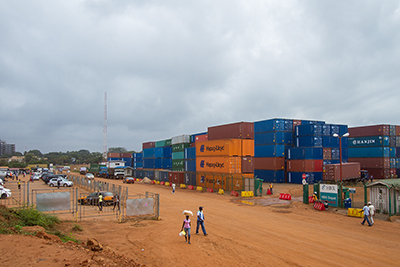

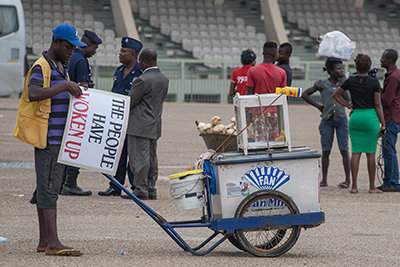


Wooden Art Crafting
A well-known art form from Africa are the most diverse decorative masks, which can also be found here and there in Germany. In Africa itself, of course, its importance goes far beyond mere decoration. Symbolism, mythology and rituals are firmly connected with them here and different forms and designs have completely different meanings, also depending on the respective region, ethnicity and culture. Accordingly, one must also assume great differences between the masks, which are made in the sense of rituals etc. and those that are aimed at tourists as mass goods on the markets.
The latter can be obtained in a wide selection, for example, at the Art Center (fig. 1) – a market in Accra where you can buy a wide range of Ghanaian art and cultural products (especially as a tourist). But when I write about 'mass goods' this does not mean that the products here are going off the production line somewhere industrially manufactured. In fact, in the Art Center itself, you can look over people's shoulders when making various products. The detailed work at the same time high speed is quite impressive – for example, in the production of the masks (Fig. 2).
In addition, there are also numerous other decorative objects and pieces of furniture made of wood, which are handmade here. These include, for example, add-on stools (pictures 3 & 4), stools, bowls and various figures.
Of course, the Art Center is far from the only alternative to acquire woodcarving art in Ghana. Looking around for others is worthwhile simply because here, as at all tourist hotspots, prices are on average slightly higher and the dealers are more intrusive. If you just open your eyes a little bit, you will find such alternatives everywhere. Figure 8 shows, for example, a group offering their wood art directly in our residential area in the north of Accras. If you still have enough space in your suitcase, you can stock up here for comparatively little money (and this for manual work) until the 23 kg baggage allowance per piece of luggage is reached.









Drums
They can already be seen in the pictures for the chapter Wood carvings and of course they also have a lot to do with them in the production – drums. Nevertheless, I would like to mention them again here, because they are also supposed to be a bit representative of music and dance in general, things that should not be overmentioned when talking about Made in Ghana. Both are very important in Ghanaian everyday life and very often drums are simply part of it.
Here, too, of course, there are numerous differences in terms of character, shape, size and design. The decorations also range from general symbols and colours to very individual motifs. Especially with music groups you can often find the name of the group immortalized on the instrument. Whether it's just as a decoration or actually as a used musical instrument – drums made in Ghana from handicrafts are always something special.







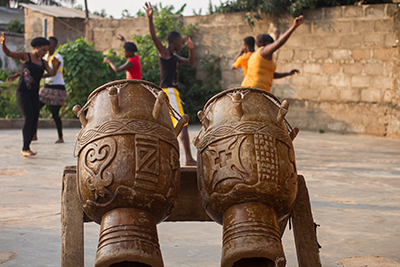

Building boats
Boat building in Ghana is also associated with wood processing, but a completely different topic. As a coastal state on the Atlantic Ocean and at the same time with the Volta, it is a large inland lake that is of great importance to boats in Ghana. Since about 10% of the Ghanaian population live from fishing, boats are conspicuously numerous, especially in this area.
The wooden boats are usually produced directly on the coasts. Here, too, there are different types and correspondingly different manufacturing processes. First of all, however, the colourful decorations and sayings that adorn the boats and make each one actually appear very individual are striking first. Very often religious verses such as God is King (fig. 8) are immortalized or simply the expression of the desire for success (Fig. 9). The colourful image at the fishing ports is also characterized by the numerous flags that adorn the palaces. Flags of parties, national flags and especially the colours and emblems of various football clubs are popular here again.
The base of a boat is obtained in the production from a tree trunk (fig. 1) and supplemented upwards by a structure at the desired height (Fig. 2). Everywhere along the Ghanaian coast you will find boats in different stages, which are either waiting for their completion (fig. 5) or have already had their best days and have been discarded.
Once a boat has been built and decorated accordingly, it is possible to go fishing, whether on the Atlantic, the Volta or the rivers. Often an outboard motor is used for this purpose, which is installed directly before the ride (Fig. 6). In contrast to the boats themselves, these are not manufactured in Ghana but usually come from the well-known large manufacturers from East Asia, Europe or the USA. However, the repair and maintenance of the corresponding engines is part of the business in Ghana.
All passengers can only wish for what the saying on the boat of Picture 9 promises – success. Because the excursions are not completely harmless, especially on open seas. The income and the expected financial profit are also usually very manageable. International aspects, which play into this and in which the EU, among others, is also closely involved, are a very specific topic.









Fishing
As already mentioned in the context of boat building, fishing in Ghana is of great importance. About 10% of the population live on it. In the context of global discussions and international economic and trade relations, this is well accompanied by problems that are also reported and debated in Europe and Germany. These include the loss of fish stocks, the threat to small fisheries by large fleets, controversial fisheries agreements, etc. There is no question that this has an impact on a population that lives on one-tenth of the way from fishing. But apart from these problems, it is also exciting to look at the lives and work of the people who are so influenced by fishing. Especially when you are on the coasts of Ghana, you can experience many exciting stories.
What you hear depends, of course, very much on who you talk to and in what context. The man who simply throws out his net on the beach (Pictures 1 & 2) has something else to tell than the fishermen who go far out to sea with their boats. However, those who do not catch the fish themselves but are nevertheless involved in fishing are also dependent on fishing. These include, for example, the boat builders, the network manufacturers and flickers (Fig. 3), those who smoke the fish (Fig. 6) or ultimately the sellers directly on the beach or at the markets.



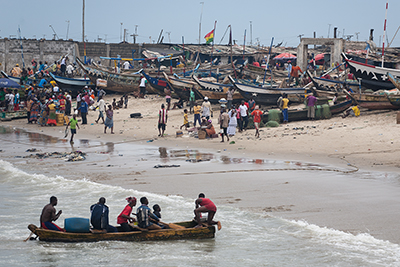





Baskets
In addition to the above-mentioned wooden objects, in Ghana you can also often find beautifully braided baskets at street shops and on the markets, which stand out due to a variety of shapes and colours. The art of braiding comes mainly from the north of the country. Through migration, trade and dissemination of this art form, however, it can of course also be found in the south and everywhere in the capital Accra. Depending on the type of lichen, different malleabilitys arise, which offer a wide range of possibilities, how such a basket can be designed.



Clothing & Shoes
Clothing plays a major role in Ghana. The focus is on the garments worn on special occasions such as church visits, weddings or funerals. Colours such as white and black (or black-red) are of great importance. Otherwise, everyday life is often colourful.
On the markets you have an enormous selection of fabrics from which you can cut clothes (Pictures 1 & 2). These are largely made in Ghana and printed with typical patterns. However, counterfeit imports from China, which manufacturers are trying to deal with, are increasingly problematic. The stated goal is to ensure that a substance purchased on a Ghanaian market also comes from the region.
From these fabrics you can have custom-made shirts and trousers made from the tailor of your choice (Pictures 3 & 4). Of course, there are also numerous prefabricated garments available everywhere in the stands. The selection is large and colorful. In addition to everyday clothes, there are also clothes for special occasions, which then have specific colour combinations and patterns. In particular, however, fabrics and clothing are symbolic-traditional, which are worn by important personalities such as the local chiefs (Fig. 8). A special form of typical Ghanaian clothing - Kente - is covered in the next section. Clothes can of course also be an expression of art, as can be seen in Picture 9, where plastic is presented as a wardrobe at a street party in Jamestown.
Similar to outerwear also applies to footwear made in Ghana. Handmade shoes are available for a wide variety of occasions in all possible shapes and materials. In Picture 10, for example, a salesman in Takoradi presents handmade sandals.
However, as mentioned earlier, there is a huge market for second-hand and clothing donation clothes in Ghana, as has already been mentioned. As a result, there are many ways for customers to dress up, as they are usually very cheap to have on the markets. For the Ghanaian textile industry, however, this poses a not insignificant challenge. The streetscape is characterized not only by colourful dresses and shirts from Ghana, but also in particular by numerous football jerseys (especially from the big English clubs and the national team of Ghana) and clothes that do not originate in Africa. Figure 11 shows a store in Accra, where retailers can pick up kilos from packaged second-hand clothes. In terms of quality and aesthetics, it is always a gamble, which is in such packages. Figure 12 shows the typical picture that can be seen in the markets for imported shoes. This is the competition for local manufacturers.


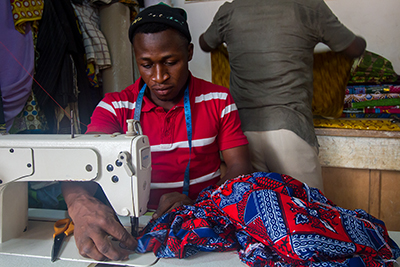






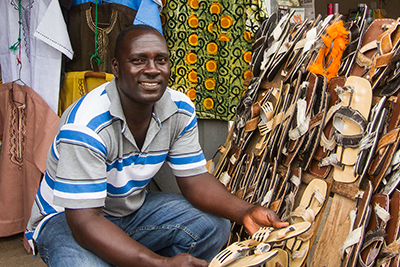


Gold
Ghana is a very resource-rich country. For example: oil, diamonds (mostly industrial diamonds), bauxite, manganese and limestone. However, the country is particularly well known for its gold deposits, which also play a relevant role in the export industry. That's the name of Ghana before independence from Britain in 1957, after all, gold coast.
In addition to the more than 230 larger companies and about 150,000 small family businesses that mine gold in the regions where there are rich gold deposits, there are also so-called Galamsey Mining – the illegal mining area on the edge of these mining areas. Micro-mining. In 2008, gold accounted for 42.6% of the country's total exports, reflecting the enormous importance of this raw material for the state. At the same time, however, problems arise again and again. These can be social in nature – e.g. when it comes to land use rights, infrastructure, etc.; or ecological, i.e. pollution and sometimes even poisoning of rivers or forest clearings to create mining areas. So, as is often the case in mining in Ghana, there are two sides of the (golden) medal.



Cocoa
In addition to gold, cocoa is another very important product in Ghana. Even before independence, it was possible to generate currency by exporting the very currency that actually promised the state a good starting point as an independent state in the world economy from an economic point of view. To this day, cocoa is an important agricultural product and the cash crop par excellence. Therefore, cocoa has always been and always is the focus of the Ghanaian government and is controlled by the Ghana Cocoa Board. Many people in Ghana also live from the cultivation of this fruit and thus partly supplement their subsistence economy.
In contrast to other agricultural products, cocoa takes quite a long time from cultivation to harvest (approximately 10 to 15 years). In addition to diseases and parasites, this is partly a challenge for cocoa farmers.
In the rural regions, one often passes cocoa farms and in the villages can see the cocoa beans that are available to dry. Contrary to the deliciously sweet end products, the fruit or Bean itself rather not for consumption. A large part of the cocoa is exported of course, but there is also chocolate made in Ghana, which is definitely worth trying.






Farming & Food
As explained above, the mentioned cocoa is an important agricultural product in Ghana, but it plays a role above all as an export commodity. Other agricultural products, on the other hand, are of greater relevance in daily life – all those that serve to prepare food, of course.
There are big differences here according to the dishes and their origin. Rice, for example, which is used for the very popular dish Jollof Rice, is imported largely from Asia. Although there is also a rice cultivation in Ghana, which is rather negligible from its everyday relevance (in the southern cities). In other foods, too, there is some competition between imported goods and local crops/holding (e.g. tomatoes and chicken).
Widely grown in Ghana, however, the main ingredients for the national dish Fufu are, for example. These include cassava (Cassava - images 1 & 2), yams and plantains (plantain - picture 3). Typical noise in Ghana is the crushing of these ingredients (fig. 4) to the mass that forms the fufu, to which a (very) spicy sauce is usually served. Other typical dishes include Banku (from corn), Rice Balls or Red-Red (Plantain with beans).
In addition to the main dishes and their ingredients, fruit also plays an important role in agriculture. Fresh from the market there are pineapples, bananas, papayas, melons or oranges. As a small snack in between, you can always have a bag of roasted peanuts or a corn cob.
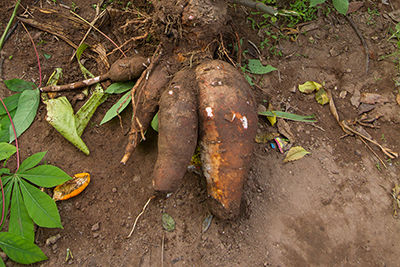

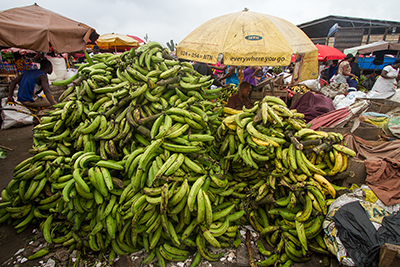




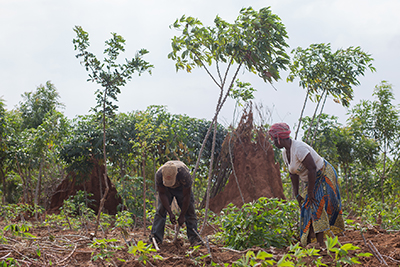

Palm Oil
Palm oil is a not uncontroversial raw material that constantly surrounds us in everyday life – be it in food or cosmetic products. Only recently has the EU imposed a labelling requirement on foodstuffs in order to force the designation of the use of palm oil from the relevant producers. The oil is viewed critically mainly because large areas of the rainforest in the tropical regions around the world have fallen victim to the cultivation of the necessary palm trees. At the same time, these events are also accompanied by discussions on so-called land grabbing.
In line with its tropical climate, palm trees are also grown in Ghana for palm oil production. This applies to large firms (including foreign participation) and small farmers. Parts of the oil obtained are exported, but it is also found in large numbers on the local markets, as it is also used in local cuisine.
In the Western Region, we were able to look at the production process of palm oil at a small family business. The palm fruits (fig. 1) are first pressed in a machine to a mass (Pictures 2 to 4), which is then heated (Fig. 5). Afterwards, this is pressed out and the palm oil is obtained (Pictures 7 & 8). The rest of the mass is then sorted out again for useful fruits (Fig. 9). Remaining remains are often used for animal feeding.



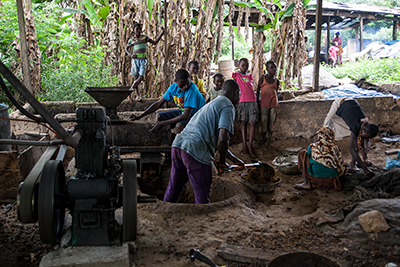





Rubber
Another popular crop in Ghana is rubber. This is an important raw material for the production of different materials. It is obtained from rubber trees, which can be found on several plantations in Ghana. To get to the rubber, the tree bark is scratched and a container is attached, which catches the viscous mass (Fig. 2).



Charcoal
Charcoal is of course an always needed good, precisely because in Ghana cooking often happens outside over an open fire. Wood extracted from shrubs and trees is covered with a layer of soil and charred. In order to obtain good charcoal, it takes a clean work and the constant repair of the resulting small hills in order to keep them tight. The product (fig. 3) is then brought to the markets or sold directly to pick-ups.






























































































